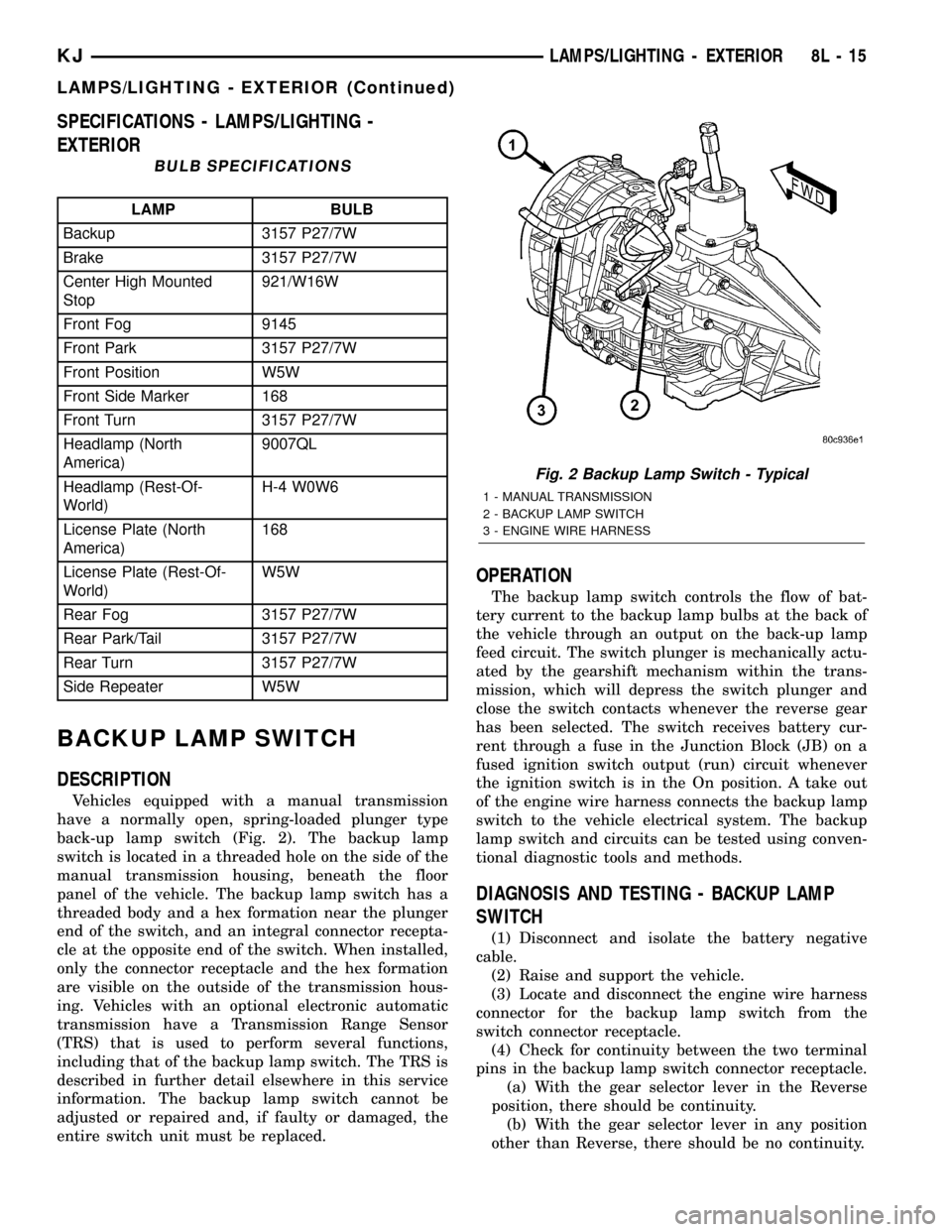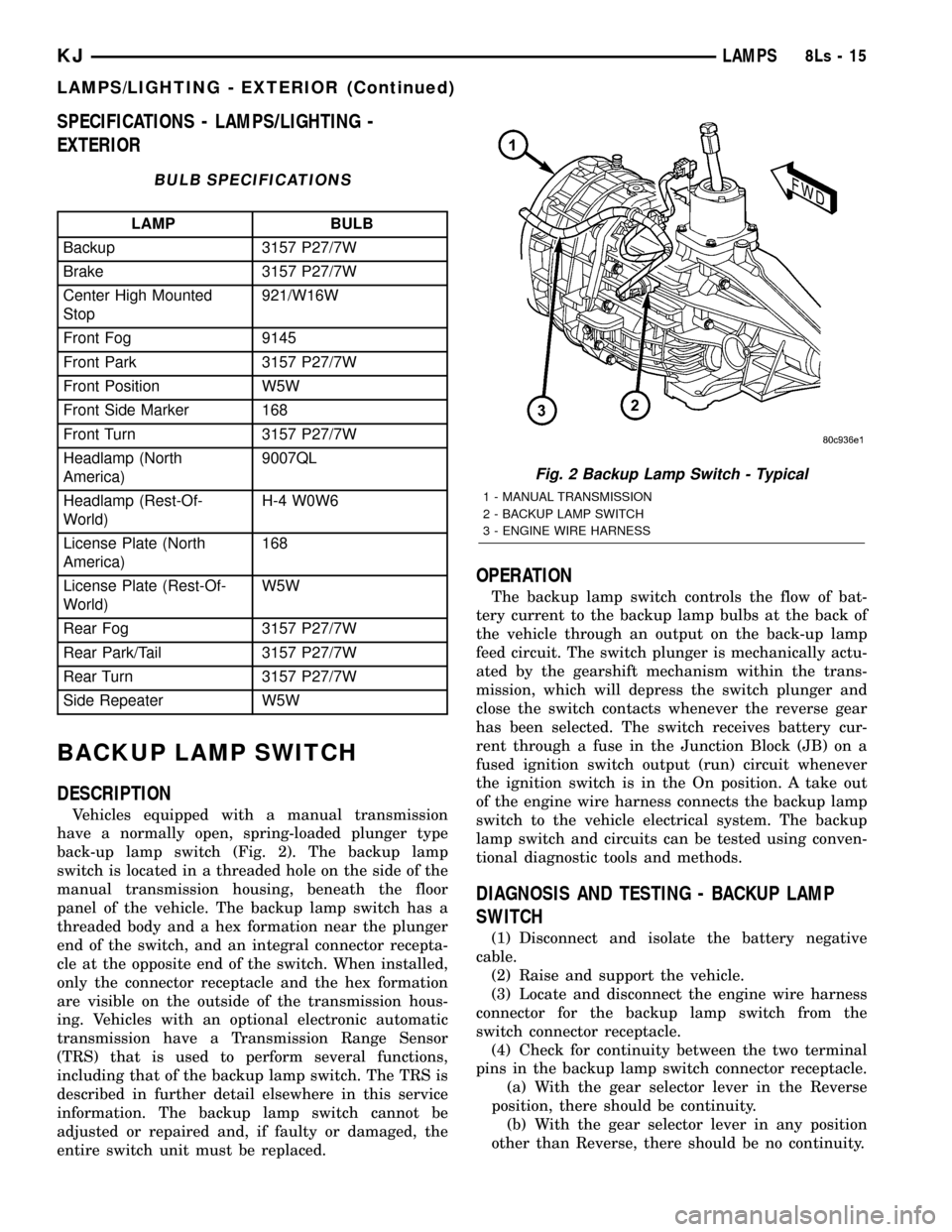Transmission control unit JEEP LIBERTY 2002 KJ / 1.G User Guide
[x] Cancel search | Manufacturer: JEEP, Model Year: 2002, Model line: LIBERTY, Model: JEEP LIBERTY 2002 KJ / 1.GPages: 1803, PDF Size: 62.3 MB
Page 456 of 1803

SPECIFICATIONS - LAMPS/LIGHTING -
EXTERIOR
BULB SPECIFICATIONS
LAMP BULB
Backup 3157 P27/7W
Brake 3157 P27/7W
Center High Mounted
Stop921/W16W
Front Fog 9145
Front Park 3157 P27/7W
Front Position W5W
Front Side Marker 168
Front Turn 3157 P27/7W
Headlamp (North
America)9007QL
Headlamp (Rest-Of-
World)H-4 W0W6
License Plate (North
America)168
License Plate (Rest-Of-
World)W5W
Rear Fog 3157 P27/7W
Rear Park/Tail 3157 P27/7W
Rear Turn 3157 P27/7W
Side Repeater W5W
BACKUP LAMP SWITCH
DESCRIPTION
Vehicles equipped with a manual transmission
have a normally open, spring-loaded plunger type
back-up lamp switch (Fig. 2). The backup lamp
switch is located in a threaded hole on the side of the
manual transmission housing, beneath the floor
panel of the vehicle. The backup lamp switch has a
threaded body and a hex formation near the plunger
end of the switch, and an integral connector recepta-
cle at the opposite end of the switch. When installed,
only the connector receptacle and the hex formation
are visible on the outside of the transmission hous-
ing. Vehicles with an optional electronic automatic
transmission have a Transmission Range Sensor
(TRS) that is used to perform several functions,
including that of the backup lamp switch. The TRS is
described in further detail elsewhere in this service
information. The backup lamp switch cannot be
adjusted or repaired and, if faulty or damaged, the
entire switch unit must be replaced.
OPERATION
The backup lamp switch controls the flow of bat-
tery current to the backup lamp bulbs at the back of
the vehicle through an output on the back-up lamp
feed circuit. The switch plunger is mechanically actu-
ated by the gearshift mechanism within the trans-
mission, which will depress the switch plunger and
close the switch contacts whenever the reverse gear
has been selected. The switch receives battery cur-
rent through a fuse in the Junction Block (JB) on a
fused ignition switch output (run) circuit whenever
the ignition switch is in the On position. A take out
of the engine wire harness connects the backup lamp
switch to the vehicle electrical system. The backup
lamp switch and circuits can be tested using conven-
tional diagnostic tools and methods.
DIAGNOSIS AND TESTING - BACKUP LAMP
SWITCH
(1) Disconnect and isolate the battery negative
cable.
(2) Raise and support the vehicle.
(3) Locate and disconnect the engine wire harness
connector for the backup lamp switch from the
switch connector receptacle.
(4) Check for continuity between the two terminal
pins in the backup lamp switch connector receptacle.
(a) With the gear selector lever in the Reverse
position, there should be continuity.
(b) With the gear selector lever in any position
other than Reverse, there should be no continuity.
Fig. 2 Backup Lamp Switch - Typical
1 - MANUAL TRANSMISSION
2 - BACKUP LAMP SWITCH
3 - ENGINE WIRE HARNESS
KJLAMPS/LIGHTING - EXTERIOR 8L - 15
LAMPS/LIGHTING - EXTERIOR (Continued)
Page 476 of 1803

INSTALLATION
WARNING: ON VEHICLES EQUIPPED WITH AIR-
BAGS, DISABLE THE SUPPLEMENTAL RESTRAINT
SYSTEM BEFORE ATTEMPTING ANY STEERING
WHEEL, STEERING COLUMN, DRIVER AIRBAG,
PASSENGER AIRBAG, SEAT BELT TENSIONER,
FRONT IMPACT SENSORS, SIDE CURTAIN AIRBAG,
OR INSTRUMENT PANEL COMPONENT DIAGNOSIS
OR SERVICE. DISCONNECT AND ISOLATE THE
BATTERY NEGATIVE (GROUND) CABLE, THEN
WAIT TWO MINUTES FOR THE SYSTEM CAPACI-
TOR TO DISCHARGE BEFORE PERFORMING FUR-
THER DIAGNOSIS OR SERVICE. THIS IS THE ONLY
SURE WAY TO DISABLE THE SUPPLEMENTAL
RESTRAINT SYSTEM. FAILURE TO TAKE THE
PROPER PRECAUTIONS COULD RESULT IN ACCI-
DENTAL AIRBAG DEPLOYMENT AND POSSIBLE
PERSONAL INJURY.
(1) Position the headlamp high beam relay to the
proper receptacle in the Junction Block (JB) (Fig. 30).
(2) Align the headlamp high beam relay terminals
with the terminal cavities in the JB receptacle.
(3) Push firmly and evenly on the top of the head-
lamp high beam relay until the terminals are fully
seated in the terminal cavities in the JB receptacle.
(4) Reinstall the end cap onto the driver side out-
board end of the instrument panel. (Refer to 23 -
BODY/INSTRUMENT PANEL/INSTRUMENT
PANEL END CAP - INSTALLATION).
(5) Reconnect the battery negative cable.
HEADLAMP LEVELING MOTOR
DESCRIPTION
The headlamp leveling motor is located on the rear
inboard side of each headlamp unit on models
equipped with the headlamp leveling system, which
is available only in certain markets where required
(Fig. 31). The motor is encased within a molded plas-
tic housing and is secured by an integral wedge-type
mounting boss on its forward surface to a flanged
receptacle on the back of the headlamp unit housing.
A rubber seal around the circumference of the
mounting boss is compressed and seals the motor to
the headlamp unit when the boss is properly
installed in the flanged receptacle. The outside of the
motor housing features an integral molded connector
receptacle on its rearward surface, a hex-headed
adjusting screw extends from the top of the housing,
and a plastic pushrod with a ball formation on its
free end extends from the center of the mounting
boss at the front. Within the motor housing is a
12-volt Direct Current (DC) servo motor, an elec-
tronic controller board that includes the motor logic
circuits, and an integral screw-drive transmission.
The headlamp leveling motor is connected to the
vehicle electrical system through a dedicated take
out and connector of the front fascia wire harness.
The headlamp leveling motor cannot be repaired
and, if faulty or damaged, the unit must be replaced.
Fig. 30 Junction Block - Outboard Side (RHD Shown
- Rotate 180É for LHD)
1 - JB/BCM CONNECTOR
2 - HIGH BEAM RELAY
3 - DRL RELAY
Fig. 31 Headlamp Unit - With Leveling
1 - LEVELING MOTOR (IF EQUIPPED)
2 - BOOT SEAL
3 - ADJUSTING SCREW
4 - LOCATOR TAB
5 - HOUSING
6 - FRONT POSITION LAMP SOCKET & BULB
7 - HEADLAMP BULB
8 - MOUNTING TAB (2)
KJLAMPS/LIGHTING - EXTERIOR 8L - 35
HEADLAMP HIGH BEAM RELAY (Continued)
Page 477 of 1803

OPERATION
The controller board and logic circuitry of the
headlamp leveling motor will energize the motor and
extend or retract the motor pushrod through the
integral screw-drive transmission based upon the
voltage signal input received from the resistor multi-
plexed headlamp leveling switch. The ball formation
on the end of the headlamp leveling motor pushrod is
snapped into a socket formation on the back of the
movable reflector within the headlamp unit housing.
The headlamp leveling motors and switch have a
path to ground at all times. The headlamp leveling
components operate on battery current received
through the fused park lamp relay output circuit so
that the system will only operate when the exterior
lighting is turned On.
Because of active electronic elements within the
headlamp leveling motor, it cannot be tested with
conventional automotive electrical test equipment. If
the headlamp leveling motor is believed to be faulty,
replace the motor with a known good unit to confirm
system operation.
REMOVAL
The headlamp leveling motors are integral to the
headlamp units on vehicles manufactured for certain
markets where headlamp leveling is required.
(1) Disconnect and isolate the battery negative
cable.
(2) Remove the headlamp bulb from the headlamp
unit housing. (Refer to 8 - ELECTRICAL/LAMPS/
LIGHTING - EXTERIOR/HEADLAMP BULB -
REMOVAL).
(3) Rotate the headlamp leveling motor on the
back of the headlamp unit housing counterclockwise
about 30 degrees (Fig. 32).
(4) Firmly grasp the motor with one hand while
stabilizing the headlamp unit housing with the other
hand.
(5) Firmly, steadily, and forcefully pull the head-
lamp leveling motor straight away from the back of
the headlamp unit housing to unsnap the ball forma-
tion on the end of the motor pushrod from the socket
on the headlamp unit reflector (Fig. 33).
(6) Remove the headlamp leveling motor and push-
rod from the back of the headlamp unit housing.
INSTALLATION
The headlamp leveling motors are integral to the
headlamp units on vehicles manufactured for certain
markets where headlamp leveling is required.
(1) Position the headlamp leveling motor and
pushrod from to the mounting hole on the back of the
headlamp unit housing.
(2) Insert two fingers through the bulb mounting
hole in the center of the headlamp reflector and pullthe reflector upwards toward the headlamp leveling
motor.
(3) Align the ball formation on the end of the lev-
eling motor pushrod with the socket on the headlamp
unit reflector (Fig. 33).
(4) While continuing to pulling the reflector
toward the motor, firmly, steadily, and forcefully push
the headlamp leveling motor straight into the back of
the headlamp unit housing to snap the ball formation
on the end of the motor pushrod into the socket on
the headlamp unit reflector.
(5) After the pushrod is engaged to the reflector,
remove your fingers from the bulb mounting hole in
Fig. 32 Headlamp Leveling Motor Remove/Install
1 - LEVELING MOTOR
2 - HEADLAMP HOUSING
3 - PUSHROD
Fig. 33 Leveling Motor Pushrod - Typical
1 - REFLECTOR PUSHROD SOCKET
2 - PUSHROD
3 - LEVELING MOTOR
4 - HEADLAMP HOUSING
8L - 36 LAMPS/LIGHTING - EXTERIORKJ
HEADLAMP LEVELING MOTOR (Continued)
Page 506 of 1803

LAMPS/LIGHTING - INTERIOR
TABLE OF CONTENTS
page page
LAMPS/LIGHTING - INTERIOR
DESCRIPTION.........................65
OPERATION...........................67
DIAGNOSIS AND TESTING - LAMPS/
LIGHTING - INTERIOR..................68
SPECIFICATIONS - LAMPS/LIGHTING -
INTERIOR...........................71
ASH RECEIVER LAMP BULB
REMOVAL.............................71
INSTALLATION.........................71
ASH RECEIVER LAMP UNIT
REMOVAL.............................72
INSTALLATION.........................72
CARGO LAMP BULB
REMOVAL.............................72
INSTALLATION.........................73
CARGO LAMP SWITCH
REMOVAL.............................73
INSTALLATION.........................74
CARGO LAMP UNIT
REMOVAL.............................74
INSTALLATION.........................74
COMPASS MINI-TRIP ILLUMINATION BULB
REMOVAL.............................74
INSTALLATION.........................75
COURTESY LAMP BULB
REMOVAL.............................75
INSTALLATION.........................76
COURTESY LAMP UNIT
REMOVAL.............................76INSTALLATION.........................77
DOOR AJAR SWITCH
DESCRIPTION.........................77
OPERATION...........................77
FLIP-UP GLASS AJAR SWITCH
DESCRIPTION.........................77
OPERATION...........................77
HEATER-A/C CONTROL ILLUMINATION BULB
REMOVAL.............................78
INSTALLATION.........................78
READING LAMP BULB
REMOVAL.............................79
INSTALLATION.........................79
READING LAMP SWITCH
REMOVAL.............................80
INSTALLATION.........................80
READING LAMP UNIT
REMOVAL.............................81
INSTALLATION.........................81
TAILGATE AJAR SWITCH
DESCRIPTION.........................82
OPERATION...........................82
TRANSMISSION RANGE INDICATOR
ILLUMINATION BULB
REMOVAL.............................82
INSTALLATION.........................83
VANITY LAMP BULB
REMOVAL.............................83
INSTALLATION.........................84
LAMPS/LIGHTING - INTERIOR
DESCRIPTION
The interior lighting system (Fig. 1) for this model
includes the following incandescent interior lamps:
²Ash Receiver Lamp- An available ash receiver
lamp is located above the ash receiver housing
behind the instrument panel center bezel, and is con-
trolled by the panel lamps dimmer circuit.
²Cargo Lamp- An available cargo lamp with an
integral lens-actuated courtesy disable switch is
located in the headliner near the rear roof header,
and is controlled by the courtesy lamp circuit.
²Courtesy Lamps- Available courtesy lamps are
located below both the right and left side of the
instrument panel, and are controlled by the courtesy
lamp circuit.²Compass Mini-Trip Control Illumination
Lamps- The optional Compass Mini-Trip Computer
(CMTC) has three replaceable control illumination
bulb/bulb holder units on its circuit board that are
controlled by the panel lamps dimmer circuit.
²Dome Lamp- A standard front dome lamp that
does not include an on-off switch is located in the
headliner near the windshield header, and is con-
trolled by the courtesy lamp circuit.
²Hazard Switch Illumination/Indicator
Lamp- The hazard switch control button has a non-
replaceable illumination/indicator bulb soldered onto
its circuit board that is controlled by both the hazard
switch circuitry and the panel lamps dimmer circuit.
(Refer to 8 - ELECTRICAL/LAMPS/LIGHTING -
EXTERIOR/HAZARD SWITCH - DESCRIPTION).
²Heater-Air Conditioner Control Illumina-
tion Lamps- The heater-air conditioner control has
KJLAMPS/LIGHTING - INTERIOR 8L - 65
Page 507 of 1803

two replaceable control illumination bulb/bulb holder
units on its circuit board that are controlled by the
panel lamps dimmer circuit.
²Instrument Cluster Illumination Lamps-
The ElectroMechanical Instrument Cluster (EMIC)
has nine replaceable general illumination bulb/bulb
holder units on its circuit board that are controlled
by the panel lamps dimmer circuit. (Refer to 8 -ELECTRICAL/INSTRUMENT CLUSTER -
DESCRIPTION).
²Reading Lamps- Available front seat driver
side and passenger side reading lamps located in the
headliner near the windshield header are controlled
by both the courtesy lamp circuit and independent
lens-actuated switches.
²Transmission Range Indicator Illumination
Lamp- Vehicles equipped with an automatic trans-
Fig. 1 Courtesy Lamps
1 - COURTESY LAMP (2)
2 - DOME OR READING LAMP3 - VANITY LAMP (2)
4 - CARGO LAMP
8L - 66 LAMPS/LIGHTING - INTERIORKJ
LAMPS/LIGHTING - INTERIOR (Continued)
Page 512 of 1803

SPECIFICATIONS - LAMPS/LIGHTING -
INTERIOR
BULB SPECIFICATIONS
LAMP BULB
Ash Receiver 161
Cargo 214-2
Cluster Illumination 103
Compass Mini-Trip
IlluminationMOPAR 4437661
Courtesy 906
Heater-A/C Control
Illumination74
Map/Reading 192
Transmission Range
Indicator IlluminationS14V
Vanity Mirror MOPAR 6501966
ASH RECEIVER LAMP BULB
REMOVAL
WARNING: ON VEHICLES EQUIPPED WITH AIR-
BAGS, DISABLE THE SUPPLEMENTAL RESTRAINT
SYSTEM BEFORE ATTEMPTING ANY STEERING
WHEEL, STEERING COLUMN, DRIVER AIRBAG,
PASSENGER AIRBAG, SEAT BELT TENSIONER,
FRONT IMPACT SENSORS, SIDE CURTAIN AIRBAG,
OR INSTRUMENT PANEL COMPONENT DIAGNOSIS
OR SERVICE. DISCONNECT AND ISOLATE THE
BATTERY NEGATIVE (GROUND) CABLE, THEN
WAIT TWO MINUTES FOR THE SYSTEM CAPACI-
TOR TO DISCHARGE BEFORE PERFORMING FUR-
THER DIAGNOSIS OR SERVICE. THIS IS THE ONLY
SURE WAY TO DISABLE THE SUPPLEMENTAL
RESTRAINT SYSTEM. FAILURE TO TAKE THE
PROPER PRECAUTIONS COULD RESULT IN ACCI-
DENTAL AIRBAG DEPLOYMENT AND POSSIBLE
PERSONAL INJURY.
(1) Disconnect and isolate the battery negative
cable.
(2) Remove the ash receiver lamp unit from the
top of the ash receiver housing. (Refer to 8 - ELEC-
TRICAL/LAMPS/LIGHTING - INTERIOR/ASH
RECEIVER LAMP UNIT - REMOVAL).
(3) Carefully disengage the ash receiver lamp hood
from the integral snap features on each side of the
lamp unit socket and remove the hood (Fig. 2).
(4) Pull the ash receiver lamp bulb straight out of
the lamp unit socket.
INSTALLATION
WARNING: ON VEHICLES EQUIPPED WITH AIRBAGS,
DISABLE THE SUPPLEMENTAL RESTRAINT SYSTEM
BEFORE ATTEMPTING ANY STEERING WHEEL,
STEERING COLUMN, DRIVER AIRBAG, PASSENGER
AIRBAG, SEAT BELT TENSIONER, FRONT IMPACT
SENSORS, SIDE CURTAIN AIRBAG, OR INSTRUMENT
PANEL COMPONENT DIAGNOSIS OR SERVICE. DIS-
CONNECT AND ISOLATE THE BATTERY NEGATIVE
(GROUND) CABLE, THEN WAIT TWO MINUTES FOR
THE SYSTEM CAPACITOR TO DISCHARGE BEFORE
PERFORMING FURTHER DIAGNOSIS OR SERVICE.
THIS IS THE ONLY SURE WAY TO DISABLE THE SUP-
PLEMENTAL RESTRAINT SYSTEM. FAILURE TO TAKE
THE PROPER PRECAUTIONS COULD RESULT IN
ACCIDENTAL AIRBAG DEPLOYMENT AND POSSIBLE
PERSONAL INJURY.
CAUTION: Always use the correct bulb size and
type for replacement. An incorrect bulb size or type
may overheat and cause damage to the lamp, the
socket and/or the lamp wiring.
(1) Align the base of the ash receiver lamp bulb
with the receptacle in the lamp unit socket.
(2) Push the ash receiver lamp bulb straight into
the lamp unit socket until it is firmly seated (Fig. 2).
(3) Carefully slide the ash receiver lamp hood onto
the lamp unit socket until it is fully engaged with
the integral snap features on each side of the socket.
(4) Reinstall the ash receiver lamp unit onto the
top of the ash receiver housing. (Refer to 8 - ELEC-
TRICAL/LAMPS/LIGHTING - INTERIOR/ASH
RECEIVER LAMP UNIT - INSTALLATION).
(5) Reconnect the battery negative cable.
Fig. 2 Ash Receiver Lamp Bulb Remove/Install
1 - SOCKET
2 - BULB
3 - HOOD
KJLAMPS/LIGHTING - INTERIOR 8L - 71
LAMPS/LIGHTING - INTERIOR (Continued)
Page 523 of 1803

TAILGATE AJAR SWITCH
DESCRIPTION
A tailgate ajar switch is standard equipment in
this vehicle. This switch is concealed within and inte-
gral to the tailgate latch unit. The switch is a
momentary leaf contact-type unit that is actuated by
the tailgate latch mechanism. A pigtail wire harness
and connector on the tailgate latch unit connects the
tailgate ajar switch to the vehicle electrical system
through the tailgate wire harness. The tailgate ajar
switch cannot be adjusted or repaired and, if faulty
or damaged, the tailgate latch unit must be replaced.
(Refer to 23 - BODY/SWING GATE/LATCH -
REMOVAL).
OPERATION
The tailgate switch is actuated by the tailgate
latch mechanism. When the tailgate is closed and
properly latched, the tailgate ajar switch is an open
circuit. When the tailgate is open or only partially
latched, the tailgate ajar switch is a closed circuit.
The tailgate ajar switch is hard wired between a
body ground and the Body Control Module (BCM).
The output of the switch is connected to the BCM
through a tailgate ajar switch sense circuit. The
BCM reads the tailgate ajar switch status through
an internal pull-up, then uses this input to control
many electronic functions and features of the vehicle.
The tailgate ajar switch can be diagnosed using con-
ventional diagnostic tools and methods; however, for
proper diagnosis of the BCM, and both the hard
wired and electronic BCM outputs affected by the
tailgate ajar switch input, a DRBIIItscan tool is
required. Refer to the appropriate diagnostic infor-
mation.
TRANSMISSION RANGE
INDICATOR ILLUMINATION
BULB
REMOVAL
WARNING: ON VEHICLES EQUIPPED WITH AIR-
BAGS, DISABLE THE SUPPLEMENTAL RESTRAINT
SYSTEM BEFORE ATTEMPTING ANY STEERING
WHEEL, STEERING COLUMN, DRIVER AIRBAG,
PASSENGER AIRBAG, SEAT BELT TENSIONER,
FRONT IMPACT SENSORS, SIDE CURTAIN AIRBAG,
OR INSTRUMENT PANEL COMPONENT DIAGNOSIS
OR SERVICE. DISCONNECT AND ISOLATE THE
BATTERY NEGATIVE (GROUND) CABLE, THEN
WAIT TWO MINUTES FOR THE SYSTEM CAPACI-
TOR TO DISCHARGE BEFORE PERFORMING FUR-
THER DIAGNOSIS OR SERVICE. THIS IS THE ONLY
SURE WAY TO DISABLE THE SUPPLEMENTAL
RESTRAINT SYSTEM. FAILURE TO TAKE THE
PROPER PRECAUTIONS COULD RESULT IN ACCI-
DENTAL AIRBAG DEPLOYMENT AND POSSIBLE
PERSONAL INJURY.
(1) Disconnect and isolate the battery negative
cable.
(2) Remove the center console from the floor panel
transmission tunnel. (Refer to 23 - BODY/INTERI-
OR/FLOOR CONSOLE - REMOVAL).
(3) From the left side of the vehicle, reach between
transmission range indicator and the floor panel
transmission tunnel to grasp the illumination lamp
socket (Fig. 15).
Fig. 15 Transmission Range Indicator Illumination
Bulb Remove/Install
1 - AUTOMATIC TRANSMISSION SHIFT MECHANISM
2 - ILLUMINATION LAMP SOCKET
8L - 82 LAMPS/LIGHTING - INTERIORKJ
Page 529 of 1803

mounted to the back of the quarter panel on each
side of the tailgate at the rear of the vehicle. The
park lamps include a license plate lamp or lamps,
depending upon the requirements of the market for
which the vehicle is manufactured. Vehicles with a
license plate tub located near the left end of the rear
bumper fascia have a single lamp, while vehicles
with a license plate module located on the spare tire
carrier have two license plate lamps. In certain mar-
kets where required, a front position lamp that is
integral to each headlamp unit is illuminated instead
of the front park lamps and front side marker lamps
in the park lamps circuit; and, a rectangular, red
reflector is located on the rear bumper fascia just
inboard and below each rear lamp unit.
²Rear Fog Lamps- Rear fog lamps are avail-
able only in certain markets where they are required
equipment. The rear fog lamps are integral to the
rear lamp units mounted to the back of the quarter
panel on each side of the tailgate at the rear of the
vehicle.
²Turn Signal Lamps- The turn signal lamps
include the front turn signal and front side marker
lamps that are integral to the front lamp units
mounted at each end of the bumper fascia at the
front of the vehicle, as well as rear turn signal lamps
that are integral to the rear lamp units mounted to
the back of the quarter panel on each side of the tail-
gate at the rear of the vehicle. In certain markets
where required, a repeater lamp unit mounted to
each front fender just behind the front wheel opening
is illuminated instead of the front side marker lamp
in each turn signal lamp circuit.
Other components of the exterior lighting system
for this model include:
²Combination Flasher- An electronic combina-
tion flasher is integral to the hazard warning switch
in the center of the instrument panel.
²Backup Lamp Switch- Vehicles equipped with
a manual transmission have a plunger-type backup
lamp switch located on the transmission housing. A
Transmission Range Sensor (TRS) integral to the
solenoid pack on the valve body of the optional elec-
tronic automatic transmission performs the backup
lamp switch function on models that are so equipped.
²Brake Lamp Switch- A plunger-type brake
lamp switch is located on the steering column sup-
port bracket under the instrument panel and actu-
ated by the brake pedal arm.²Body Control Module- The Body Control
Module (BCM) is located on the Junction Block (JB)
under the driver side outboard end of the instrument
panel. (Refer to 8 - ELECTRICAL/ELECTRONIC
CONTROL MODULES/BODY CONTROL MODULE
- DESCRIPTION).
²Daytime Running Lamp Relay- Vehicles
manufactured for sale in Canada use a solid state
Daytime Running Lamps (DRL) relay installed in the
Junction Block (JB) instead of the conventional high
beam relay.
²Front Fog Lamp Relay- Vehicles equipped
with the optional front fog lamps have a front fog
lamp relay located in the Junction Block (JB).
²Hazard Switch- The hazard switch is located
near the center of the instrument panel and includes
the integral electronic combination flasher circuitry
for the hazard warning system and the turn signal
system.
²Headlamp Leveling Motor- A headlamp lev-
eling actuator motor is located on the back of each
headlamp housing of vehicles manufactured for cer-
tain markets where this equipment is required.
²Headlamp Leveling Switch- A thumbwheel
actuated headlamp leveling switch is mounted in the
driver side inboard instrument panel trim bezel of
vehicles manufactured for certain markets where this
equipment is required.
²High Beam Relay- A high beam relay is
located in the Junction Block (JB) of all vehicles
except those that are manufactured for sale in Can-
ada. Canadian vehicles have a solid state Daytime
Running Lamps (DRL) relay in the JB instead of the
high beam relay.
²Low Beam Relay- A low beam relay is located
in the Junction Block (JB) of all vehicles.
²Multi-Function Switch- The multi-function
switch is located on the top of the steering column,
just below the steering wheel. The multi-function
switch includes a left (lighting) control stalk and a
right (wiper) control stalk. The left control stalk is
dedicated to providing almost all of the driver con-
trols for both the exterior and interior lighting sys-
tems.
²Park Lamp Relay- A park lamp relay is
located in the Junction Block (JB) of all vehicles.
²Rear Fog Lamp Relay- Vehicles manufac-
tured for certain markets where rear fog lamps are
required equipment have a rear fog lamp relay
located in the Junction Block (JB).
1 - HEADLAMP UNIT (2)
2 - REPEATER LAMP UNIT (2)
3 - FRONT POSITION LAMP (2)
4 - FRONT LAMP UNIT (2)5 - FRONT FOG LAMP (2)
6 - CENTER HIGH MOUNTED STOP LAMP UNIT
7 - REAR LAMP UNIT
8 - LICENSE PLATE LAMP UNIT
8Ls - 4 LAMPSKJ
LAMPS/LIGHTING - EXTERIOR (Continued)
Page 540 of 1803

SPECIFICATIONS - LAMPS/LIGHTING -
EXTERIOR
BULB SPECIFICATIONS
LAMP BULB
Backup 3157 P27/7W
Brake 3157 P27/7W
Center High Mounted
Stop921/W16W
Front Fog 9145
Front Park 3157 P27/7W
Front Position W5W
Front Side Marker 168
Front Turn 3157 P27/7W
Headlamp (North
America)9007QL
Headlamp (Rest-Of-
World)H-4 W0W6
License Plate (North
America)168
License Plate (Rest-Of-
World)W5W
Rear Fog 3157 P27/7W
Rear Park/Tail 3157 P27/7W
Rear Turn 3157 P27/7W
Side Repeater W5W
BACKUP LAMP SWITCH
DESCRIPTION
Vehicles equipped with a manual transmission
have a normally open, spring-loaded plunger type
back-up lamp switch (Fig. 2). The backup lamp
switch is located in a threaded hole on the side of the
manual transmission housing, beneath the floor
panel of the vehicle. The backup lamp switch has a
threaded body and a hex formation near the plunger
end of the switch, and an integral connector recepta-
cle at the opposite end of the switch. When installed,
only the connector receptacle and the hex formation
are visible on the outside of the transmission hous-
ing. Vehicles with an optional electronic automatic
transmission have a Transmission Range Sensor
(TRS) that is used to perform several functions,
including that of the backup lamp switch. The TRS is
described in further detail elsewhere in this service
information. The backup lamp switch cannot be
adjusted or repaired and, if faulty or damaged, the
entire switch unit must be replaced.
OPERATION
The backup lamp switch controls the flow of bat-
tery current to the backup lamp bulbs at the back of
the vehicle through an output on the back-up lamp
feed circuit. The switch plunger is mechanically actu-
ated by the gearshift mechanism within the trans-
mission, which will depress the switch plunger and
close the switch contacts whenever the reverse gear
has been selected. The switch receives battery cur-
rent through a fuse in the Junction Block (JB) on a
fused ignition switch output (run) circuit whenever
the ignition switch is in the On position. A take out
of the engine wire harness connects the backup lamp
switch to the vehicle electrical system. The backup
lamp switch and circuits can be tested using conven-
tional diagnostic tools and methods.
DIAGNOSIS AND TESTING - BACKUP LAMP
SWITCH
(1) Disconnect and isolate the battery negative
cable.
(2) Raise and support the vehicle.
(3) Locate and disconnect the engine wire harness
connector for the backup lamp switch from the
switch connector receptacle.
(4) Check for continuity between the two terminal
pins in the backup lamp switch connector receptacle.
(a) With the gear selector lever in the Reverse
position, there should be continuity.
(b) With the gear selector lever in any position
other than Reverse, there should be no continuity.
Fig. 2 Backup Lamp Switch - Typical
1 - MANUAL TRANSMISSION
2 - BACKUP LAMP SWITCH
3 - ENGINE WIRE HARNESS
KJLAMPS8Ls-15
LAMPS/LIGHTING - EXTERIOR (Continued)
Page 560 of 1803

INSTALLATION
WARNING: ON VEHICLES EQUIPPED WITH AIR-
BAGS, DISABLE THE SUPPLEMENTAL RESTRAINT
SYSTEM BEFORE ATTEMPTING ANY STEERING
WHEEL, STEERING COLUMN, DRIVER AIRBAG,
PASSENGER AIRBAG, SEAT BELT TENSIONER,
FRONT IMPACT SENSORS, SIDE CURTAIN AIRBAG,
OR INSTRUMENT PANEL COMPONENT DIAGNOSIS
OR SERVICE. DISCONNECT AND ISOLATE THE
BATTERY NEGATIVE (GROUND) CABLE, THEN
WAIT TWO MINUTES FOR THE SYSTEM CAPACI-
TOR TO DISCHARGE BEFORE PERFORMING FUR-
THER DIAGNOSIS OR SERVICE. THIS IS THE ONLY
SURE WAY TO DISABLE THE SUPPLEMENTAL
RESTRAINT SYSTEM. FAILURE TO TAKE THE
PROPER PRECAUTIONS COULD RESULT IN ACCI-
DENTAL AIRBAG DEPLOYMENT AND POSSIBLE
PERSONAL INJURY.
(1) Position the headlamp high beam relay to the
proper receptacle in the Junction Block (JB) (Fig. 30).
(2) Align the headlamp high beam relay terminals
with the terminal cavities in the JB receptacle.
(3) Push firmly and evenly on the top of the head-
lamp high beam relay until the terminals are fully
seated in the terminal cavities in the JB receptacle.
(4) Reinstall the end cap onto the driver side out-
board end of the instrument panel. (Refer to 23 -
BODY/INSTRUMENT PANEL/INSTRUMENT
PANEL END CAP - INSTALLATION).
(5) Reconnect the battery negative cable.
HEADLAMP LEVELING MOTOR
DESCRIPTION
The headlamp leveling motor is located on the rear
inboard side of each headlamp unit on models
equipped with the headlamp leveling system, which
is available only in certain markets where required
(Fig. 31). The motor is encased within a molded plas-
tic housing and is secured by an integral wedge-type
mounting boss on its forward surface to a flanged
receptacle on the back of the headlamp unit housing.
A rubber seal around the circumference of the
mounting boss is compressed and seals the motor to
the headlamp unit when the boss is properly
installed in the flanged receptacle. The outside of the
motor housing features an integral molded connector
receptacle on its rearward surface, a hex-headed
adjusting screw extends from the top of the housing,
and a plastic pushrod with a ball formation on its
free end extends from the center of the mounting
boss at the front. Within the motor housing is a
12-volt Direct Current (DC) servo motor, an elec-
tronic controller board that includes the motor logic
circuits, and an integral screw-drive transmission.
The headlamp leveling motor is connected to the
vehicle electrical system through a dedicated take
out and connector of the front fascia wire harness.
The headlamp leveling motor cannot be repaired
and, if faulty or damaged, the unit must be replaced.
Fig. 30 Junction Block - Outboard Side (RHD Shown
- Rotate 180É for LHD)
1 - JB/BCM CONNECTOR
2 - HIGH BEAM RELAY
3 - DRL RELAY
Fig. 31 Headlamp Unit - With Leveling
1 - LEVELING MOTOR (IF EQUIPPED)
2 - BOOT SEAL
3 - ADJUSTING SCREW
4 - LOCATOR TAB
5 - HOUSING
6 - FRONT POSITION LAMP SOCKET & BULB
7 - HEADLAMP BULB
8 - MOUNTING TAB (2)
KJLAMPS8Ls-35
HEADLAMP HIGH BEAM RELAY (Continued)